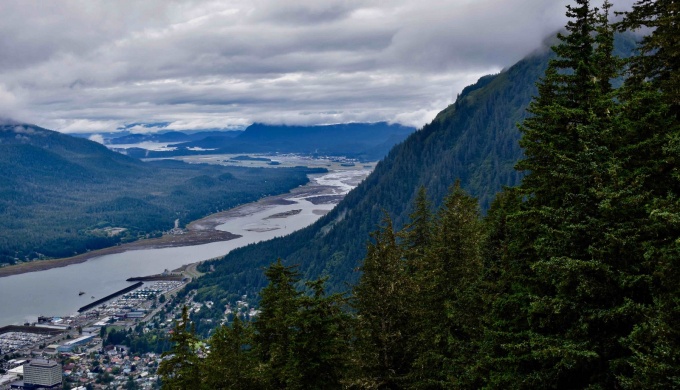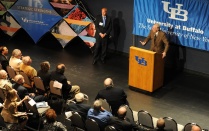NSF grant supports research project by Charlotte Lindqvist and team

The National Science Foundation (NSF) has awarded a grant, totaling $2,945,234., to support a UB Biological Sciences study on the impacts of climate change. The study's principal investigator is Charlotte Lindqvist. Co-principal investigators are Jason Briner, Elizabeth Thomas, and Corey Krabbenhoft.
The study will invest in interdisciplinary STEM training and career-building to educate the next generation of multidisciplinary scientists, including training of postdocs and a cohort of graduate and undergraduate students spanning different disciplines.
The study will also offer interdisciplinary seminars, a 1-credit course, summer continuing education programs for science teachers in Buffalo City high schools, and an outreach program targeting K-12 students in Southeast Alaska.
News of the federal funding was announced August 5, 2022 by U.S. Senate Majority Leader Charles E. Schumer and U.S. Senator Kirsten Gillibrand. Schumer said that this critical research is integral to understanding how rapid climatic shifts affects species, the environment, and broadening our understanding on the impacts of global warming.
“Buffalo is leading New York and our nation in the fight against climate change. I am proud to deliver this nearly $3 million federal investment to research the impacts of climate change on species, bolster local scientific education programs, and further boost Western New York’s research leadership,” said Senator Schumer.
“Top-tier research institutions like the University at Buffalo are leading the fight against climate change, and we need their innovative ideas and solutions now more than ever,” said Senator Gillibrand.
“The University at Buffalo is deeply committed to addressing climate change and the ongoing sustainability crisis,” said UB President Satish K. Tripathi. “With this National Science Foundation award, our world-class scientists will be able to further climate science research, ultimately contributing to the understanding and mitigation of one of the preeminent issues facing our nation and world.
Read the full press release, here.
Research Study: Integrating paleogenomics, ecology, and geology to predict organism-environment coupled evolution during rapid warming and ice sheet retreat
Over the last century, global climate has experienced marked temperature increases that have incurred environmental, biotic, and societal impacts. Research on organismal responses to climate change have often concentrated on single or closely-interrelated species, and over short to very recent timescales. The long-term effects from the amplitude and duration of climate-change remain largely unknown because species are embedded in complex networks of interactions with one another and the environments they live in, and because there is substantial variation in responses among species over space and time. While the Earth’s global temperatures have fluctuated repeatedly over its entire history, the abrupt changes that took place just after the last Ice Age are particularly useful analogs for processes occurring today. This research will focus on prehistoric climate perturbations in Southeast Alaska, an ideal natural laboratory that holds exceptional geologic archives of past biological and climate change. The region is a hotspot of biological diversity that hosted remarkable shifts of native species over the past ~40 thousand years and served as a crucial gateway for early human migration into the New World. The assembled team of scholars, with cross-disciplinary expertise across the biological and geological sciences, will examine how Southeast Alaskan ecosystems responded to Ice-Age environmental change. This research will provide important insights into how rapid climatic shifts can serve as triggers for dramatic and irreversible downstream impacts on both native and colonizing species. The project will invest in interdisciplinary STEM training and career-building to educate the next generation of multidisciplinary scientists, including training of postdocs and a cohort of graduate and undergraduate students spanning different disciplines. It will also offer interdisciplinary seminars, a 1-credit course, summer continuing education programs for science teachers in Buffalo City high schools, and an outreach program targeting K-12 students in Southeast Alaska.
Global warming is occurring at an unprecedented rapid pace in the history of Earth, and its effects are predicted to include loss of sea ice, accelerated sea level rise, changes in weather patterns, shifts in geographic ranges for plants, animals and pathogens, lengthening of growing seasons and flowering times, and extinction risks. This project will integrate paleoecological and paleoclimatic information with genetic data to uncover ecosystem changes across a region that evolved through a backdrop of considerable temperature, ice sheet, and sea level transitions. Employing a convergent research approach that combines expertise in paleogenomics, ecology, geology and paleoclimatology, the project will focus on the Last Glacial Maximum to Holocene transition and three Holocene rapid warming events in Southeast Alaska, which will serve as a model system for a new and general paradigm. Invoking the ecological concept of “alternative stable states” over evolutionary time, the research will test the hypothesis that in response to past climate change, ecosystems underwent regime shifts characterized by alternative stable states, environmental tipping points, and periods of rapid community turnover. This research will fill important spatial and temporal gaps in high-resolution, terrestrial climate records spanning a period of dramatic climate change and define universal principles and emergent properties that underlie ecosystem shifts in response to rapid environmental transformation, including a better understanding of how environmental variation impacts ecosystem resilience. The project will invest in interdisciplinary STEM training and career-building to educate the next generation of multidisciplinary scientists, including training of postdocs and a cohort of graduate and undergraduate students spanning different disciplines. It will also offer interdisciplinary seminars, a 1-credit course, summer continuing education programs for science teachers in Buffalo City high schools, and an outreach program targeting K-12 students in Southeast Alaska.
This award reflects NSF's statutory mission and has been deemed worthy of support through evaluation using the Foundation's intellectual merit and broader impacts review criteria.
